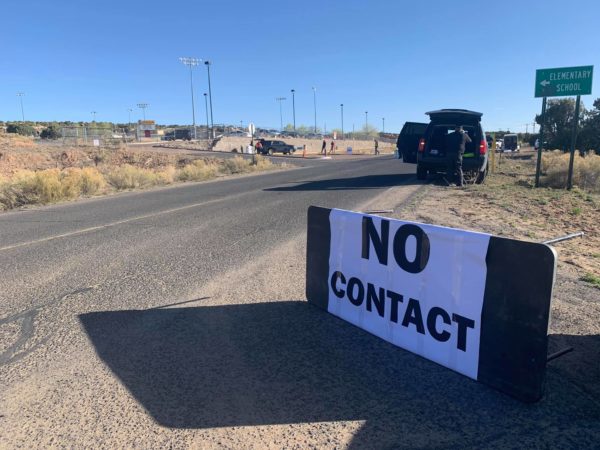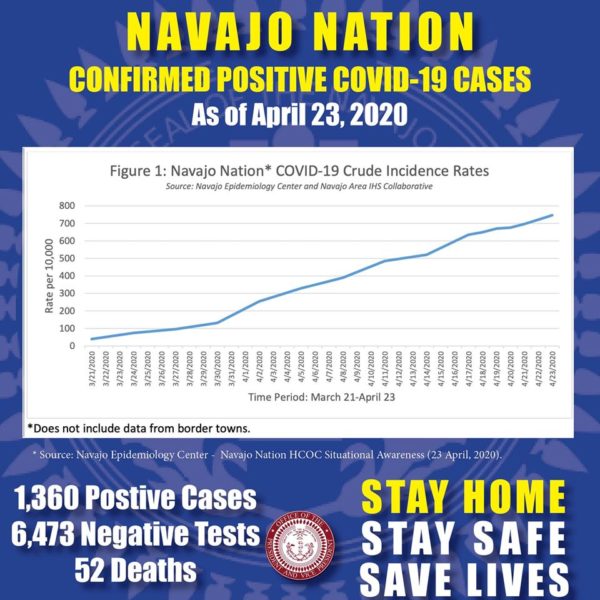
- Details
- By Levi Rickert
WINDOW ROCK, Ariz. — An additional three Navajo Nation citizens have died in the novel coronavirus pandemic, according to Navajo Nation data released Thursday, which means the total deaths surpassed 50 from Wednesday to Thursday. The total death toll stands at 52.
The Navajo Nation also saw 78 new cases of coronavirus reported on the Navajo Nation as of Thursday. The total case count is now at 1,360.
The Navajo Department of Health in coordination with the Navajo Epidemiology Center and the Navajo Area Indian Health Service provided a breakdown of the total cases by gender: 642 men and 718 women with an average age of 48-years-old. There is a total of 6,473 negative test results.
The 1,360 confirmed positive cases on the Navajo Nation include the following counties:
· Navajo County, AZ: 350 · Apache County, AZ: 287 · Coconino County, AZ: 229 · McKinley County, NM: 296 · San Juan County, NM: 135 · Cibola County, NM: 14 · San Juan County, UT: 19 · Socorro County, NM: 17 · Sandoval County, NM: 13
The Navajo Epidemiology Center has validated a daily decrease of COVID-19 cases. However the Nation has not reached its peak of overall positive cases.
There are currently seven Navajo Nation Public Health Emergency Orders to reduce the spread of COVID-19, which is a contributing factor for the daily decrease of cases. The orders include a Nation-wide shelter-in-place, limiting large gatherings, a daily curfew from 8:00 p.m. to 5:00 a.m., a 57-hour weekend curfew during the month of April, and mandating all individuals on the Navajo Nation to wear face masks.

“The proactive measures that we’ve put in place are working to slow down the virus, so let’s keep it up. During this pandemic, we need to remember that we are all related in one way or another and we should help one another and that includes holding each other accountable. We have a Nation-wide shelter-in-place order, but we can’t be everywhere to ensure compliance by the people," Navajo Nation President Jonathan Nez commented.
To Donate to the Navajo Nation
The official webpage for donations to the Navajo Nation, which has further details on how to support the Nation’s Dikos Ntsaaígíí-19 (COVID-19) efforts is: http://www.nndoh.org/donate.html.
For More Information
For more information including reports, helpful prevention tips, and more resources, please visit the Navajo Department of Health’s COVID-19 website at http://www.ndoh.navajo-nsn.
For up to date information on impact the coronavirus pandemic is having in the United States and around the world go to: https://www.worldometers.info/coronavirus/country/us/?fbclid=IwAR1vxfcHfMBnmTFm6hBICQcdbV5aRnMimeP3hVYHdlxJtFWdKF80VV8iHgE
For up-to-date information about COVID-19, Native News Online encourages you to go to Indian Health Service’s COVID-19 webpage and review CDC’s COVID-19 webpage.
How to help Native News Online: Send us news. Sign up for our daily enewsletter. Follow us on Facebook and Twitter. Share our articles. You can also donate to Native News Online here. Most importantly, take care of yourself. Megwetch.
More Stories Like This
Native News Weekly (August 25, 2024): D.C. BriefsUS Presidents in Their Own Words Concerning American Indians
Native News Weekly (December 14, 2025): D.C. Briefs
Wounded Knee Massacre Site Protection Bill Passes Congress
Two Murdered on Colville Indian Reservation
Help us defend tribal sovereignty.
At Native News Online, our mission is rooted in telling the stories that strengthen sovereignty and uplift Indigenous voices — not just at year’s end, but every single day.
Because of your generosity last year, we were able to keep our reporters on the ground in tribal communities, at national gatherings and in the halls of Congress — covering the issues that matter most to Indian Country: sovereignty, culture, education, health and economic opportunity.
That support sustained us through a tough year in 2025. Now, as we look to the year ahead, we need your help right now to ensure warrior journalism remains strong — reporting that defends tribal sovereignty, amplifies Native truth, and holds power accountable.
 The stakes couldn't be higher. Your support keeps Native voices heard, Native stories told and Native sovereignty defended.
The stakes couldn't be higher. Your support keeps Native voices heard, Native stories told and Native sovereignty defended.
Stand with Warrior Journalism today.
Levi Rickert (Potawatomi), Editor & Publisher

